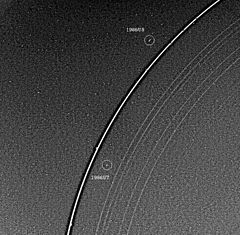- There is also an asteroid called 171 Ophelia.
 Discovery image of Ophelia (top of image, outside of rings) | |
| Discovery | |
|---|---|
| Discovered by | Richard J. Terrile / Voyager 2 |
| Discovery date | January 20, 1986 |
| Mean orbit radius | 53,763.390 ± 0.847 km[1] |
| Eccentricity | 0.00992 ± 0.000107[1] |
| Orbital period | 0.37640039 ± 0.00000357 d[1] |
| Inclination | 0.10362 ± 0.055° (to Uranus' equator)[1] |
| Satellite of | Uranus |
| Physical characteristics | |
| Dimensions | 54 × 38 × 38 km[2] |
| Mean radius | 21.4 ± 4 km[2][3][4] |
| Surface area | ~6600 km²[5] |
| Volume | ~41,000 km³[5] |
| Mass | ~5.3 × 1016 kg[5] |
| Mean density | ~1.3 g/cm³ assumed[3] |
| Equatorial surface gravity | ~0.0070 m/s2[5] |
| Escape velocity | ~0.018 km/s[5] |
| Rotation period | synchronous[2] |
| Axial tilt | zero[2] |
| Albedo | 0.08 ± 0.01 [6] 0.07[3][4] |
| Temperature | ~64 K[5] |
| | |
Ophelia (pronounced /ɵˈfiːliə/ o-FEE-lee-ə) is a moon of Uranus. It was discovered from the images taken by Voyager 2 on January 20, 1986 and was given the temporary designation S/1986 U 8.[7] It was not seen until the Hubble Space Telescope recovered it in 2003.[6][8] Ophelia was named after the daughter of Polonius, Ophelia, in William Shakespeare's play Hamlet. It is also designated Uranus VII.[9]
Unfortunately, other than its orbit,[1] radius of 21 km[2] and geometric albedo of 0.08[6] virtually nothing is known about it. At the Voyager 2 images Ophelia appears as an elongated object, the major axis pointing towards Uranus. The ratio of axises of the Ophelia's prolate spheroid is 0.7 ± 0.3.[2]
Ophelia acts as the outer shepherd satellite for Uranus' Epsilon ring.[10] The orbit of Ophelia is within the synchronous orbit radius of Uranus, and therefore the moon is slowly decaying due to tidal forces.[2]
0 comments:
Post a Comment